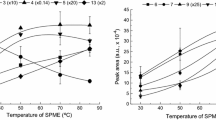Abstract
One of the main limitations to the use of direct coupling of headspace mass spectrometry (HS-MS) for the quantitative determination of analytes in a sample is related to factors affecting the signal intensity. The importance of strategies aimed at compensating this problem is considerable in the case of classification, and is indeed critical as regards the problems involved in quantification. This paper reports the effects of the different factors affecting HS-MS signal intensity in the quantification of the pollution of beach sands by hydrocarbons—the matrix effect, signal instability over time and nature of the different pollutants present in the polluted sands—and proposes possible solutions. Signal instability was solved by using a multiplicative calibration transfer algorithm. A three-factor Box–Behnken experimental design was used to study the matrix effect, mainly as regards the moisture of the samples, and the results are discussed.










Similar content being viewed by others
References
Reddy CM, Quinn JG (1999) Mar Pollut Bull 38:126–135
Wang Z, Fingas M, Sigouin L (2001) J Chromatogr A 909:155–169
Wang Z, Li K, Fingas M, Sigouin L, Ménard L (2002) J Chromatogr A 971:173–184
Sakata SK, Taniguchi S, Rodrigues DF, Urano ME, Wandermüren MN, Pellizari VH, Comasseto JV (2004) J Chromatogr A 1048:67–71
Pérez Pavón JL, Guerrero Peña A, García Pinto C, Moreno Cordero B (2004) J Chromatogr A 1047:101–109
Peña F, Cárdenas S, Gallego M, Valcárcel M (2004) J Chromatogr A 1052:137–143
Dittmann B, Zimmermann B, Engelen C, Jany G, Nitz S (2000) J Agric Food Chem 48:2887–2892
Goodner KL, Rouseff RL (2001) J Agric Food Chem 49:250–253
Pérès C, Denoyer C, Tournayre P, Berdagué JL (2002) Anal Chem 74:1386–1392
Marsili RT (1999) J Agric Food Chem 47:648–654
Pérés C, Viallon C, Berdagué JL (2001) Anal Chem 73:1030–1036
Creaser CS, Lamarca DG, Brum J, Werner C, New AP, dos-Santos LMF (2002) Anal Chem 74:300–304
Radovic BS, Goodacre R, Auklam E (2001) J Anal Appl Pyrolysis 60:79–87
Pérez Pavón JL, del Nogal Sánchez M, García Pinto C, Fernández Laespada ME, Moreno Cordero B (2003) Anal Chem 75:6361–6367
Marcos Lorenzo I, Pérez Pavón JL, Fernández Laespada ME, García Pinto C, Moreno Cordero B, Henriques LR, Peres MF, Simões MP, Lopes PS (2002) Anal Bioanal Chem 374:1205–1211
Peña F, Cárdenas S, Gallego M, Valcárcel M (2004) Anal Chim Acta 526:77–82
Pérès C, Begnaud F, Eveleigh L, Berdagué JL (2003) Trends Anal Chem 22:858–866
Pérez Pavón JL, del Nogal Sánchez M, García Pinto C, Fernández Laespada ME, Moreno Cordero B, Guerrero Peña A (2003) Anal Chem 75:2034–2041
Pirouette (2000) Comprehensive chemometrics modeling software infometrix, Inc., Version 30. Woodinville, WA
The Umscrambler Version 7.8 (2002) Camo Process AS. Oslo, Norway
Box GEP, Benhken DW (1960) Technometrics 2:455–476
Acknowledgements
We acknowledge the DGI (Project CTQ2004-01370/BQU) and the Consejería de Educación y Cultura of the Junta de Castilla y León y la Unión Europea (Fondo Social Europeo. Project SA079/02) for financial support of this research. M.N.S. acknowledges financial support by the Junta de Castilla y León.
Author information
Authors and Affiliations
Corresponding author
Rights and permissions
About this article
Cite this article
del Nogal Sánchez, M., Pérez Pavón, J.L., Fernández Laespada, M.E. et al. Factors affecting signal intensity in headspace mass spectrometry for the determination of hydrocarbon pollution in beach sands. Anal Bioanal Chem 382, 372–380 (2005). https://doi.org/10.1007/s00216-005-3114-7
Received:
Revised:
Accepted:
Published:
Issue Date:
DOI: https://doi.org/10.1007/s00216-005-3114-7




